2001 CHRYSLER VOYAGER ECU
[x] Cancel search: ECUPage 6 of 4284
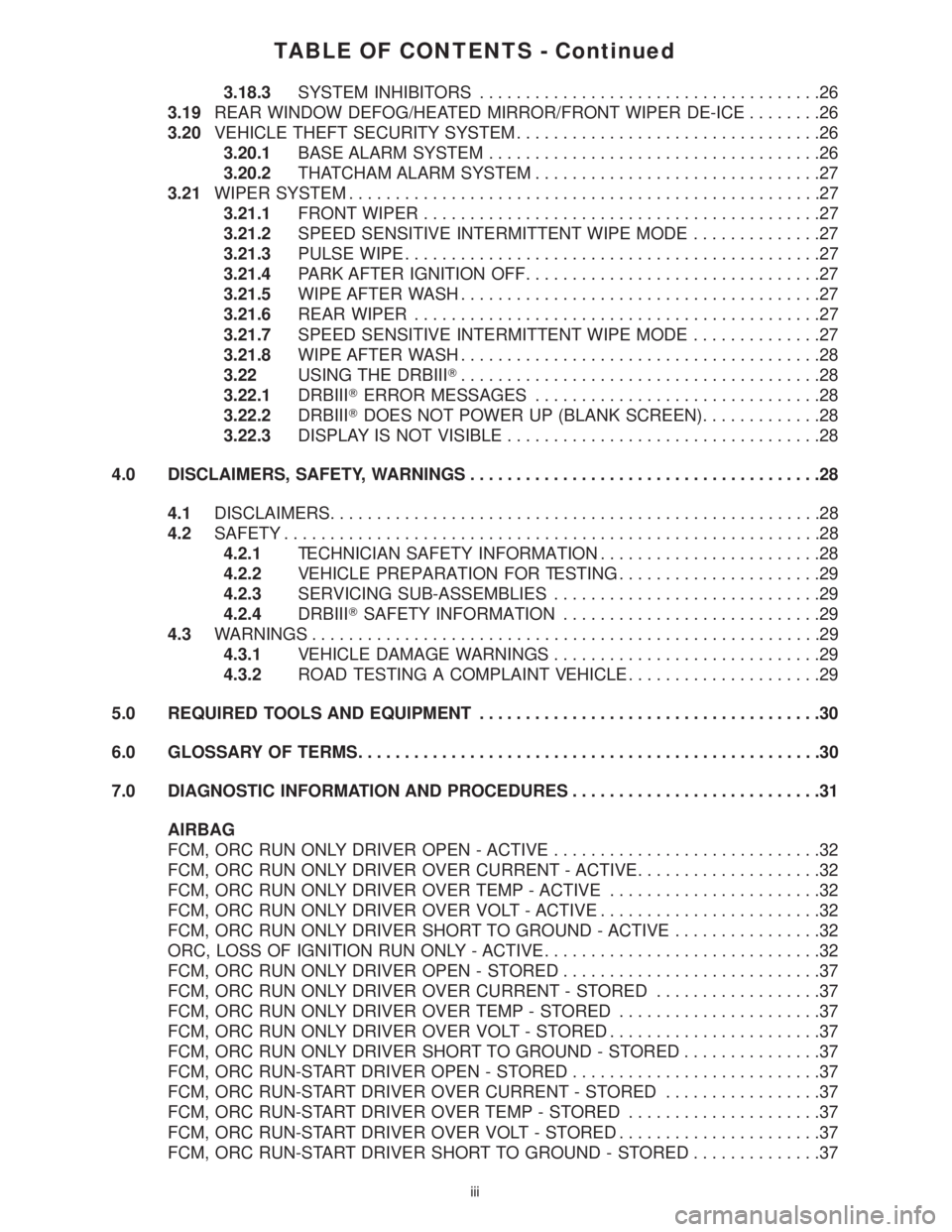
TABLE OF CONTENTS - Continued
3.18.3SYSTEM INHIBITORS.....................................26
3.19REAR WINDOW DEFOG/HEATED MIRROR/FRONT WIPER DE-ICE........26
3.20VEHICLE THEFT SECURITY SYSTEM.................................26
3.20.1BASE ALARM SYSTEM....................................26
3.20.2THATCHAM ALARM SYSTEM...............................27
3.21WIPER SYSTEM...................................................27
3.21.1FRONT WIPER...........................................27
3.21.2SPEED SENSITIVE INTERMITTENT WIPE MODE..............27
3.21.3PULSE WIPE.............................................27
3.21.4PARK AFTER IGNITION OFF................................27
3.21.5WIPE AFTER WASH.......................................27
3.21.6REAR WIPER............................................27
3.21.7SPEED SENSITIVE INTERMITTENT WIPE MODE..............27
3.21.8WIPE AFTER WASH.......................................28
3.22USING THE DRBIIIT.......................................28
3.22.1DRBIIITERROR MESSAGES...............................28
3.22.2DRBIIITDOES NOT POWER UP (BLANK SCREEN).............28
3.22.3DISPLAY IS NOT VISIBLE..................................28
4.0 DISCLAIMERS, SAFETY, WARNINGS......................................28
4.1DISCLAIMERS.....................................................28
4.2SAFETY..........................................................28
4.2.1TECHNICIAN SAFETY INFORMATION........................28
4.2.2VEHICLE PREPARATION FOR TESTING......................29
4.2.3SERVICING SUB-ASSEMBLIES.............................29
4.2.4DRBIIITSAFETY INFORMATION............................29
4.3WARNINGS.......................................................29
4.3.1VEHICLE DAMAGE WARNINGS.............................29
4.3.2ROAD TESTING A COMPLAINT VEHICLE.....................29
5.0 REQUIRED TOOLS AND EQUIPMENT.....................................30
6.0 GLOSSARY OF TERMS..................................................30
7.0 DIAGNOSTIC INFORMATION AND PROCEDURES...........................31
AIRBAG
FCM, ORC RUN ONLY DRIVER OPEN - ACTIVE.............................32
FCM, ORC RUN ONLY DRIVER OVER CURRENT - ACTIVE....................32
FCM, ORC RUN ONLY DRIVER OVER TEMP - ACTIVE.......................32
FCM, ORC RUN ONLY DRIVER OVER VOLT - ACTIVE........................32
FCM, ORC RUN ONLY DRIVER SHORT TO GROUND - ACTIVE................32
ORC, LOSS OF IGNITION RUN ONLY - ACTIVE..............................32
FCM, ORC RUN ONLY DRIVER OPEN - STORED............................37
FCM, ORC RUN ONLY DRIVER OVER CURRENT - STORED..................37
FCM, ORC RUN ONLY DRIVER OVER TEMP - STORED......................37
FCM, ORC RUN ONLY DRIVER OVER VOLT - STORED.......................37
FCM, ORC RUN ONLY DRIVER SHORT TO GROUND - STORED...............37
FCM, ORC RUN-START DRIVER OPEN - STORED...........................37
FCM, ORC RUN-START DRIVER OVER CURRENT - STORED.................37
FCM, ORC RUN-START DRIVER OVER TEMP - STORED.....................37
FCM, ORC RUN-START DRIVER OVER VOLT - STORED......................37
FCM, ORC RUN-START DRIVER SHORT TO GROUND - STORED..............37
iii
Page 20 of 4284
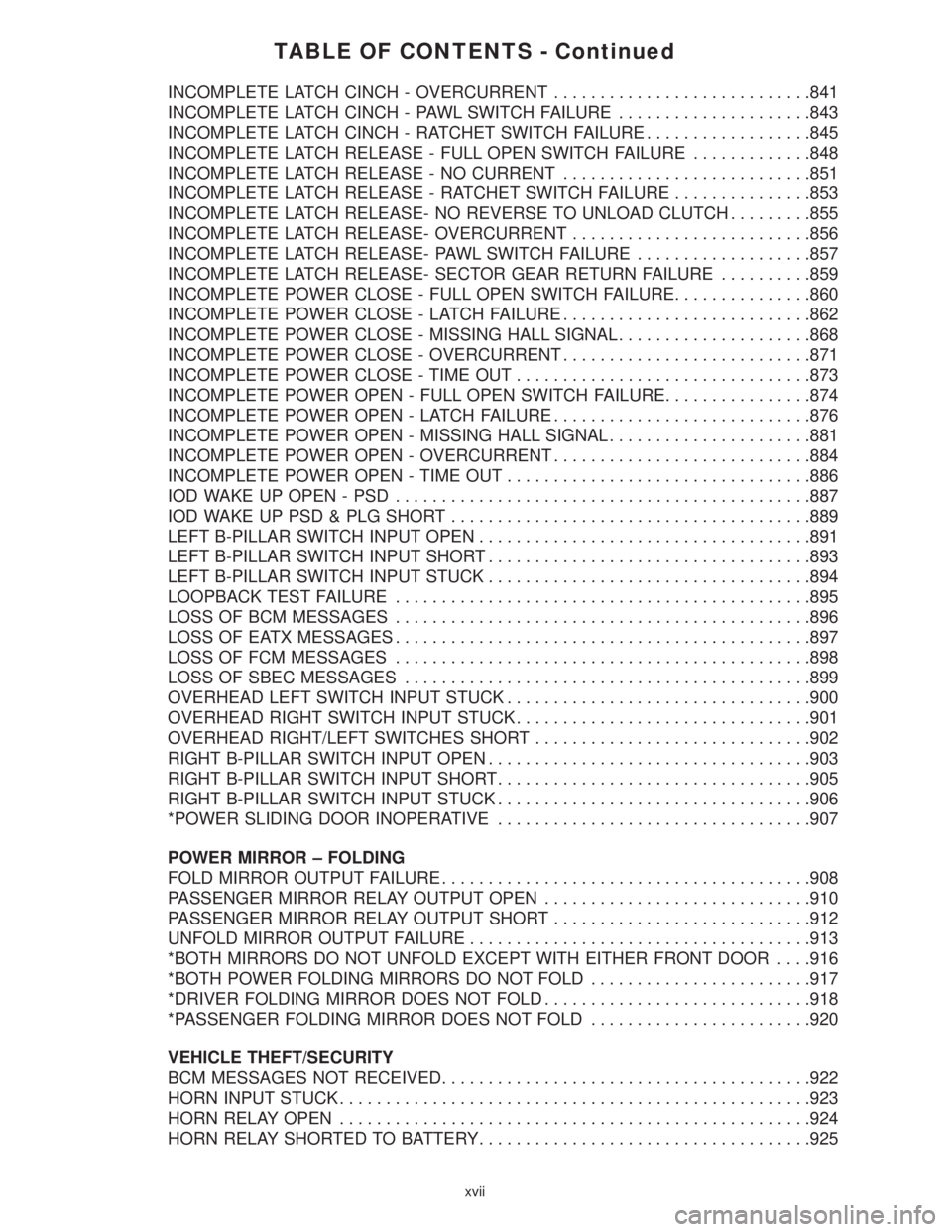
TABLE OF CONTENTS - Continued
INCOMPLETE LATCH CINCH - OVERCURRENT............................841
INCOMPLETE LATCH CINCH - PAWL SWITCH FAILURE.....................843
INCOMPLETE LATCH CINCH - RATCHET SWITCH FAILURE..................845
INCOMPLETE LATCH RELEASE - FULL OPEN SWITCH FAILURE.............848
INCOMPLETE LATCH RELEASE - NO CURRENT...........................851
INCOMPLETE LATCH RELEASE - RATCHET SWITCH FAILURE...............853
INCOMPLETE LATCH RELEASE- NO REVERSE TO UNLOAD CLUTCH.........855
INCOMPLETE LATCH RELEASE- OVERCURRENT..........................856
INCOMPLETE LATCH RELEASE- PAWL SWITCH FAILURE...................857
INCOMPLETE LATCH RELEASE- SECTOR GEAR RETURN FAILURE..........859
INCOMPLETE POWER CLOSE - FULL OPEN SWITCH FAILURE...............860
INCOMPLETE POWER CLOSE - LATCH FAILURE...........................862
INCOMPLETE POWER CLOSE - MISSING HALL SIGNAL.....................868
INCOMPLETE POWER CLOSE - OVERCURRENT...........................871
INCOMPLETE POWER CLOSE - TIME OUT................................873
INCOMPLETE POWER OPEN - FULL OPEN SWITCH FAILURE................874
INCOMPLETE POWER OPEN - LATCH FAILURE............................876
INCOMPLETE POWER OPEN - MISSING HALL SIGNAL......................881
INCOMPLETE POWER OPEN - OVERCURRENT............................884
INCOMPLETE POWER OPEN - TIME OUT.................................886
IOD WAKE UPOPEN - PSD .............................................887
IOD WAKE UP PSD & PLG SHORT.......................................889
LEFT B-PILLAR SWITCH INPUT OPEN....................................891
LEFT B-PILLAR SWITCH INPUT SHORT...................................893
LEFT B-PILLAR SWITCH INPUT STUCK...................................894
LOOPBACK TEST FAILURE.............................................895
LOSS OF BCM MESSAGES.............................................896
LOSS OF EATX MESSAGES.............................................897
LOSS OF FCM MESSAGES.............................................898
LOSS OF SBEC MESSAGES............................................899
OVERHEAD LEFT SWITCH INPUT STUCK.................................900
OVERHEAD RIGHT SWITCH INPUT STUCK................................901
OVERHEAD RIGHT/LEFT SWITCHES SHORT..............................902
RIGHT B-PILLAR SWITCH INPUT OPEN...................................903
RIGHT B-PILLAR SWITCH INPUT SHORT..................................905
RIGHT B-PILLAR SWITCH INPUT STUCK..................................906
*POWER SLIDING DOOR INOPERATIVE..................................907
POWER MIRROR ± FOLDING
FOLD MIRROR OUTPUT FAILURE........................................908
PASSENGER MIRROR RELAY OUTPUT OPEN.............................910
PASSENGER MIRROR RELAY OUTPUT SHORT............................912
UNFOLD MIRROR OUTPUT FAILURE.....................................913
*BOTH MIRRORS DO NOT UNFOLD EXCEPT WITH EITHER FRONT DOOR. . . .916
*BOTH POWER FOLDING MIRRORS DO NOT FOLD........................917
*DRIVER FOLDING MIRROR DOES NOT FOLD.............................918
*PASSENGER FOLDING MIRROR DOES NOT FOLD........................920
VEHICLE THEFT/SECURITY
BCM MESSAGES NOT RECEIVED........................................922
HORN INPUT STUCK...................................................923
HORN RELAY OPEN...................................................924
HORN RELAY SHORTED TO BATTERY....................................925
xvii
Page 22 of 4284
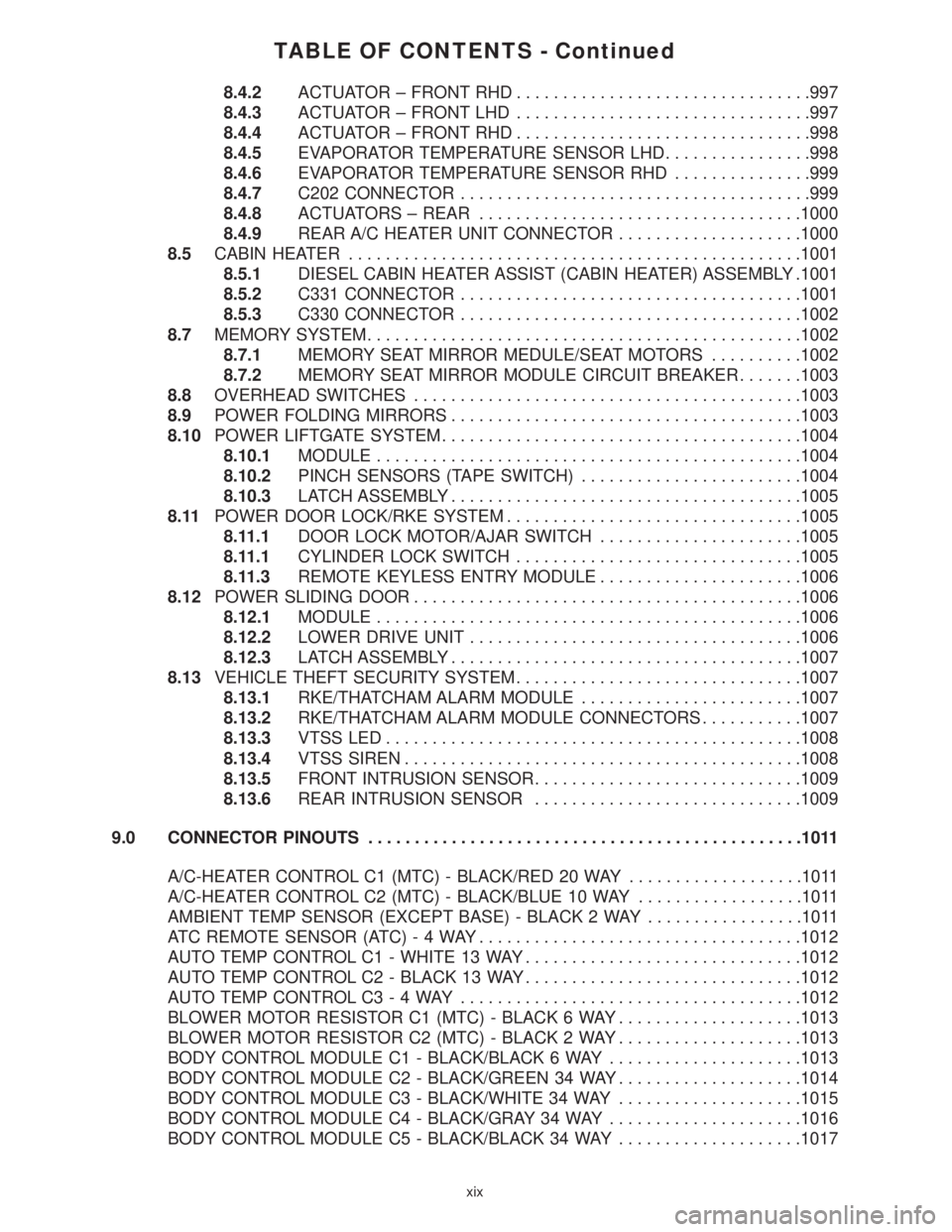
TABLE OF CONTENTS - Continued
8.4.2ACTUATOR ± FRONT RHD................................997
8.4.3ACTUATOR ± FRONT LHD................................997
8.4.4ACTUATOR ± FRONT RHD................................998
8.4.5EVAPORATOR TEMPERATURE SENSOR LHD................998
8.4.6EVAPORATOR TEMPERATURE SENSOR RHD...............999
8.4.7C202 CONNECTOR......................................999
8.4.8ACTUATORS ± REAR...................................1000
8.4.9REAR A/C HEATER UNIT CONNECTOR....................1000
8.5CABIN HEATER.................................................1001
8.5.1DIESEL CABIN HEATER ASSIST (CABIN HEATER) ASSEMBLY .1001
8.5.2C331 CONNECTOR.....................................1001
8.5.3C330 CONNECTOR.....................................1002
8.7MEMORY SYSTEM...............................................1002
8.7.1MEMORY SEAT MIRROR MEDULE/SEAT MOTORS..........1002
8.7.2MEMORY SEAT MIRROR MODULE CIRCUIT BREAKER.......1003
8.8OVERHEAD SWITCHES..........................................1003
8.9POWER FOLDING MIRRORS......................................1003
8.10POWER LIFTGATE SYSTEM.......................................1004
8.10.1MODULE..............................................1004
8.10.2PINCH SENSORS (TAPE SWITCH)........................1004
8.10.3LATCH ASSEMBLY......................................1005
8.11POWER DOOR LOCK/RKE SYSTEM................................1005
8.11.1DOOR LOCK MOTOR/AJAR SWITCH......................1005
8.11.1CYLINDER LOCK SWITCH...............................1005
8.11.3REMOTE KEYLESS ENTRY MODULE......................1006
8.12POWER SLIDING DOOR..........................................1006
8.12.1MODULE..............................................1006
8.12.2LOWER DRIVE UNIT....................................1006
8.12.3LATCH ASSEMBLY......................................1007
8.13VEHICLE THEFT SECURITY SYSTEM...............................1007
8.13.1RKE/THATCHAM ALARM MODULE........................1007
8.13.2RKE/THATCHAM ALARM MODULE CONNECTORS...........1007
8.13.3VTSS LED.............................................1008
8.13.4VTSS SIREN...........................................1008
8.13.5FRONT INTRUSION SENSOR.............................1009
8.13.6REAR INTRUSION SENSOR.............................1009
9.0 CONNECTOR PINOUTS...............................................1011
A/C-HEATER CONTROL C1 (MTC) - BLACK/RED 20 WAY...................1011
A/C-HEATER CONTROL C2 (MTC) - BLACK/BLUE 10 WAY..................1011
AMBIENT TEMP SENSOR (EXCEPT BASE) - BLACK 2 WAY.................1011
ATC REMOTE SENSOR (ATC)-4WAY...................................1012
AUTO TEMP CONTROL C1 - WHITE 13 WAY..............................1012
AUTO TEMP CONTROL C2 - BLACK 13 WAY..............................1012
AUTO TEMP CONTROL C3-4WAY.....................................1012
BLOWER MOTOR RESISTOR C1 (MTC) - BLACK 6 WAY....................1013
BLOWER MOTOR RESISTOR C2 (MTC) - BLACK 2 WAY....................1013
BODY CONTROL MODULE C1 - BLACK/BLACK 6 WAY.....................1013
BODY CONTROL MODULE C2 - BLACK/GREEN 34 WAY....................1014
BODY CONTROL MODULE C3 - BLACK/WHITE 34 WAY....................1015
BODY CONTROL MODULE C4 - BLACK/GRAY 34 WAY.....................1016
BODY CONTROL MODULE C5 - BLACK/BLACK 34 WAY....................1017
xix
Page 28 of 4284
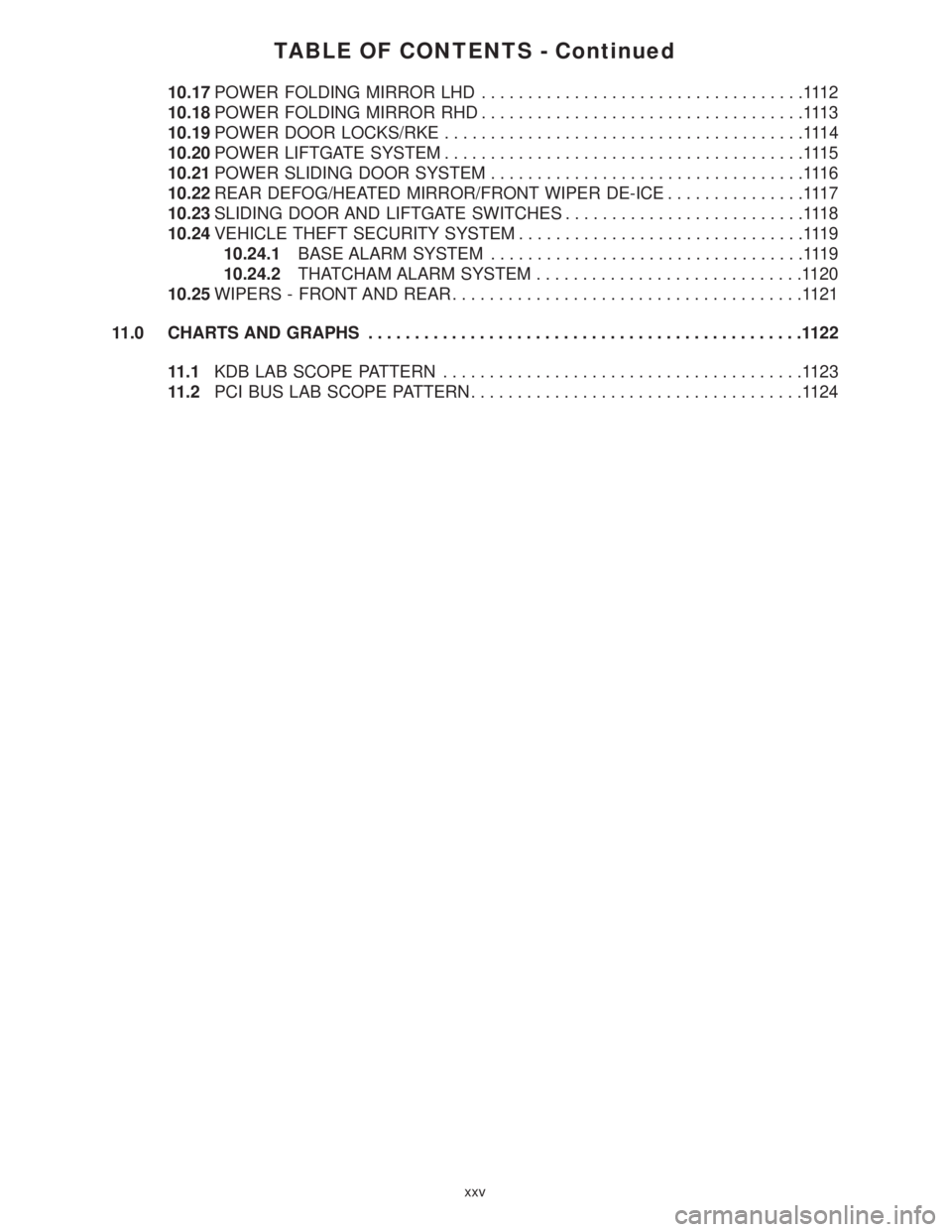
TABLE OF CONTENTS - Continued
10.17POWER FOLDING MIRROR LHD...................................1112
10.18POWER FOLDING MIRROR RHD...................................1113
10.19POWER DOOR LOCKS/RKE.......................................1114
10.20POWER LIFTGATE SYSTEM.......................................1115
10.21POWER SLIDING DOOR SYSTEM..................................1116
10.22REAR DEFOG/HEATED MIRROR/FRONT WIPER DE-ICE...............1117
10.23SLIDING DOOR AND LIFTGATE SWITCHES..........................1118
10.24VEHICLE THEFT SECURITY SYSTEM...............................1119
10.24.1BASE ALARM SYSTEM..................................1119
10.24.2THATCHAM ALARM SYSTEM.............................1120
10.25WIPERS - FRONT AND REAR......................................1121
11.0 CHARTS AND GRAPHS...............................................1122
11.1KDB LAB SCOPE PATTERN.......................................1123
11.2PCI BUS LAB SCOPE PATTERN....................................1124
xxv
Page 30 of 4284
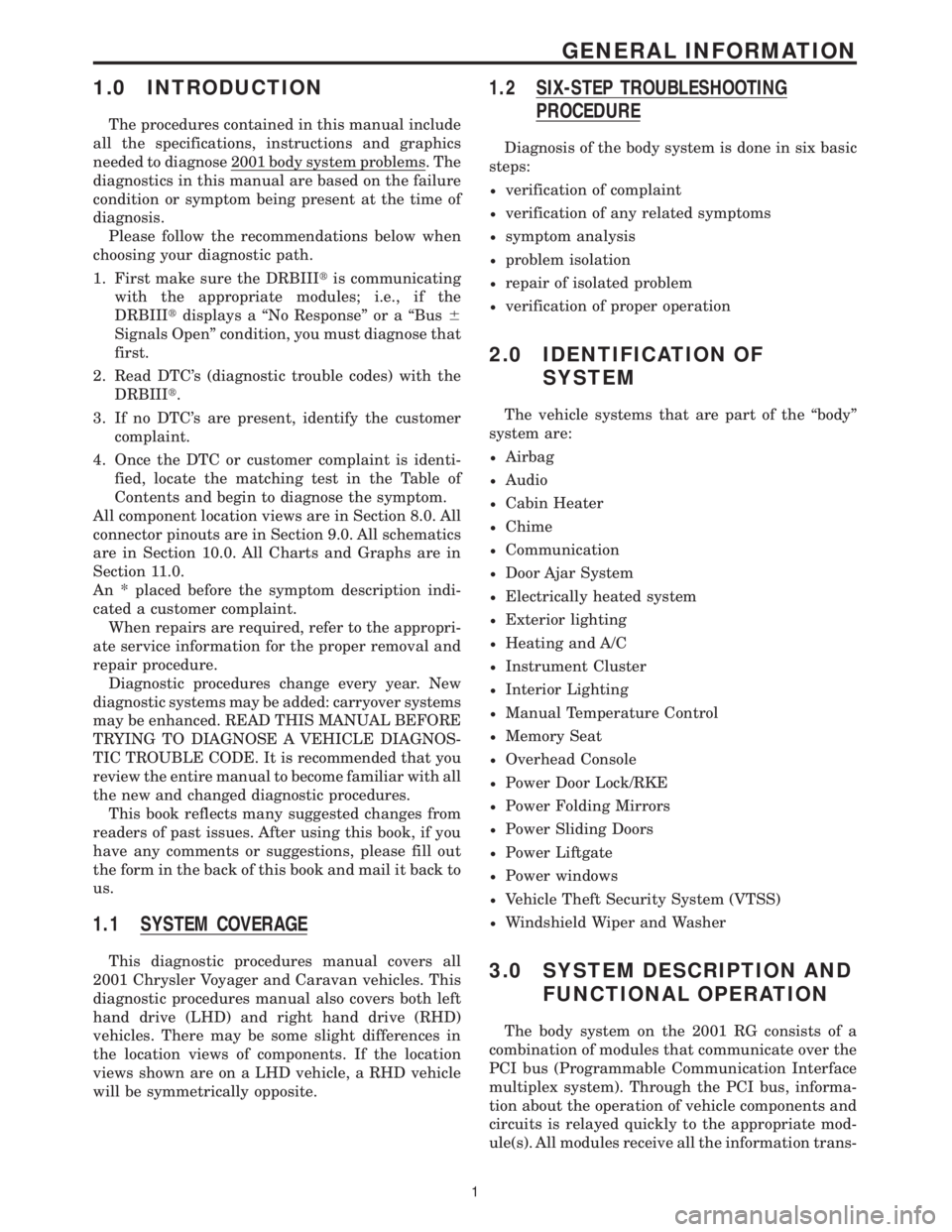
1.0 INTRODUCTION
The procedures contained in this manual include
all the specifications, instructions and graphics
needed to diagnose 2001 body system problems. The
diagnostics in this manual are based on the failure
condition or symptom being present at the time of
diagnosis.
Please follow the recommendations below when
choosing your diagnostic path.
1. First make sure the DRBIIItis communicating
with the appropriate modules; i.e., if the
DRBIIItdisplays a ªNo Responseº or a ªBus6
Signals Openº condition, you must diagnose that
first.
2. Read DTC's (diagnostic trouble codes) with the
DRBIIIt.
3. If no DTC's are present, identify the customer
complaint.
4. Once the DTC or customer complaint is identi-
fied, locate the matching test in the Table of
Contents and begin to diagnose the symptom.
All component location views are in Section 8.0. All
connector pinouts are in Section 9.0. All schematics
are in Section 10.0. All Charts and Graphs are in
Section 11.0.
An * placed before the symptom description indi-
cated a customer complaint.
When repairs are required, refer to the appropri-
ate service information for the proper removal and
repair procedure.
Diagnostic procedures change every year. New
diagnostic systems may be added: carryover systems
may be enhanced. READ THIS MANUAL BEFORE
TRYING TO DIAGNOSE A VEHICLE DIAGNOS-
TIC TROUBLE CODE. It is recommended that you
review the entire manual to become familiar with all
the new and changed diagnostic procedures.
This book reflects many suggested changes from
readers of past issues. After using this book, if you
have any comments or suggestions, please fill out
the form in the back of this book and mail it back to
us.
1.1 SYSTEM COVERAGE
This diagnostic procedures manual covers all
2001 Chrysler Voyager and Caravan vehicles. This
diagnostic procedures manual also covers both left
hand drive (LHD) and right hand drive (RHD)
vehicles. There may be some slight differences in
the location views of components. If the location
views shown are on a LHD vehicle, a RHD vehicle
will be symmetrically opposite.
1.2 SIX-STEP TROUBLESHOOTING
PROCEDURE
Diagnosis of the body system is done in six basic
steps:
²verification of complaint
²verification of any related symptoms
²symptom analysis
²problem isolation
²repair of isolated problem
²verification of proper operation
2.0 IDENTIFICATION OF
SYSTEM
The vehicle systems that are part of the ªbodyº
system are:
²Airbag
²Audio
²Cabin Heater
²Chime
²Communication
²Door Ajar System
²Electrically heated system
²Exterior lighting
²Heating and A/C
²Instrument Cluster
²Interior Lighting
²Manual Temperature Control
²Memory Seat
²Overhead Console
²Power Door Lock/RKE
²Power Folding Mirrors
²Power Sliding Doors
²Power Liftgate
²Power windows
²Vehicle Theft Security System (VTSS)
²Windshield Wiper and Washer
3.0 SYSTEM DESCRIPTION AND
FUNCTIONAL OPERATION
The body system on the 2001 RG consists of a
combination of modules that communicate over the
PCI bus (Programmable Communication Interface
multiplex system). Through the PCI bus, informa-
tion about the operation of vehicle components and
circuits is relayed quickly to the appropriate mod-
ule(s). All modules receive all the information trans-
1
GENERAL INFORMATION
Page 31 of 4284
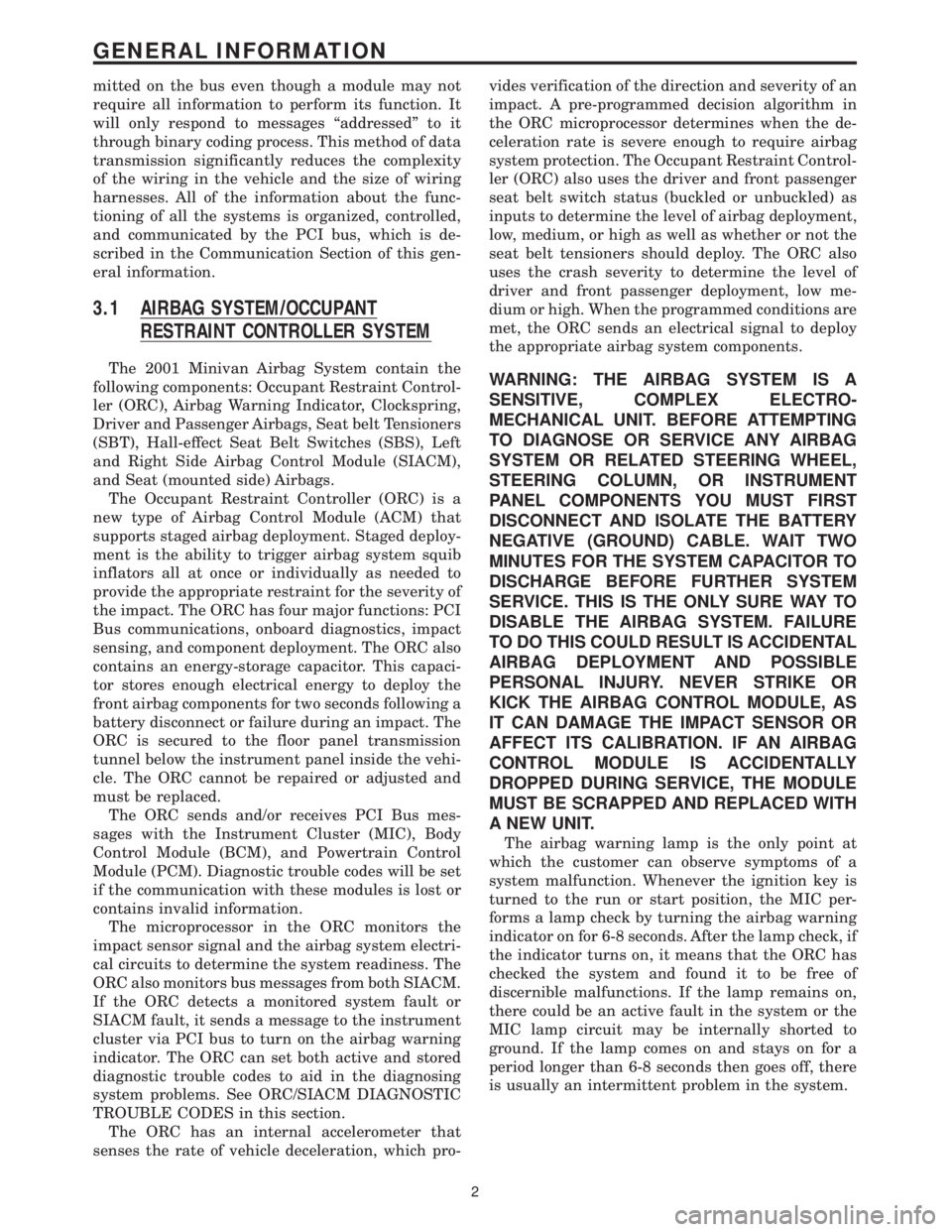
mitted on the bus even though a module may not
require all information to perform its function. It
will only respond to messages ªaddressedº to it
through binary coding process. This method of data
transmission significantly reduces the complexity
of the wiring in the vehicle and the size of wiring
harnesses. All of the information about the func-
tioning of all the systems is organized, controlled,
and communicated by the PCI bus, which is de-
scribed in the Communication Section of this gen-
eral information.
3.1 AIRBAG SYSTEM/OCCUPANT
RESTRAINT CONTROLLER SYSTEM
The 2001 Minivan Airbag System contain the
following components: Occupant Restraint Control-
ler (ORC), Airbag Warning Indicator, Clockspring,
Driver and Passenger Airbags, Seat belt Tensioners
(SBT), Hall-effect Seat Belt Switches (SBS), Left
and Right Side Airbag Control Module (SIACM),
and Seat (mounted side) Airbags.
The Occupant Restraint Controller (ORC) is a
new type of Airbag Control Module (ACM) that
supports staged airbag deployment. Staged deploy-
ment is the ability to trigger airbag system squib
inflators all at once or individually as needed to
provide the appropriate restraint for the severity of
the impact. The ORC has four major functions: PCI
Bus communications, onboard diagnostics, impact
sensing, and component deployment. The ORC also
contains an energy-storage capacitor. This capaci-
tor stores enough electrical energy to deploy the
front airbag components for two seconds following a
battery disconnect or failure during an impact. The
ORC is secured to the floor panel transmission
tunnel below the instrument panel inside the vehi-
cle. The ORC cannot be repaired or adjusted and
must be replaced.
The ORC sends and/or receives PCI Bus mes-
sages with the Instrument Cluster (MIC), Body
Control Module (BCM), and Powertrain Control
Module (PCM). Diagnostic trouble codes will be set
if the communication with these modules is lost or
contains invalid information.
The microprocessor in the ORC monitors the
impact sensor signal and the airbag system electri-
cal circuits to determine the system readiness. The
ORC also monitors bus messages from both SIACM.
If the ORC detects a monitored system fault or
SIACM fault, it sends a message to the instrument
cluster via PCI bus to turn on the airbag warning
indicator. The ORC can set both active and stored
diagnostic trouble codes to aid in the diagnosing
system problems. See ORC/SIACM DIAGNOSTIC
TROUBLE CODES in this section.
The ORC has an internal accelerometer that
senses the rate of vehicle deceleration, which pro-vides verification of the direction and severity of an
impact. A pre-programmed decision algorithm in
the ORC microprocessor determines when the de-
celeration rate is severe enough to require airbag
system protection. The Occupant Restraint Control-
ler (ORC) also uses the driver and front passenger
seat belt switch status (buckled or unbuckled) as
inputs to determine the level of airbag deployment,
low, medium, or high as well as whether or not the
seat belt tensioners should deploy. The ORC also
uses the crash severity to determine the level of
driver and front passenger deployment, low me-
dium or high. When the programmed conditions are
met, the ORC sends an electrical signal to deploy
the appropriate airbag system components.WARNING: THE AIRBAG SYSTEM IS A
SENSITIVE, COMPLEX ELECTRO-
MECHANICAL UNIT. BEFORE ATTEMPTING
TO DIAGNOSE OR SERVICE ANY AIRBAG
SYSTEM OR RELATED STEERING WHEEL,
STEERING COLUMN, OR INSTRUMENT
PANEL COMPONENTS YOU MUST FIRST
DISCONNECT AND ISOLATE THE BATTERY
NEGATIVE (GROUND) CABLE. WAIT TWO
MINUTES FOR THE SYSTEM CAPACITOR TO
DISCHARGE BEFORE FURTHER SYSTEM
SERVICE. THIS IS THE ONLY SURE WAY TO
DISABLE THE AIRBAG SYSTEM. FAILURE
TO DO THIS COULD RESULT IS ACCIDENTAL
AIRBAG DEPLOYMENT AND POSSIBLE
PERSONAL INJURY. NEVER STRIKE OR
KICK THE AIRBAG CONTROL MODULE, AS
IT CAN DAMAGE THE IMPACT SENSOR OR
AFFECT ITS CALIBRATION. IF AN AIRBAG
CONTROL MODULE IS ACCIDENTALLY
DROPPED DURING SERVICE, THE MODULE
MUST BE SCRAPPED AND REPLACED WITH
A NEW UNIT.
The airbag warning lamp is the only point at
which the customer can observe symptoms of a
system malfunction. Whenever the ignition key is
turned to the run or start position, the MIC per-
forms a lamp check by turning the airbag warning
indicator on for 6-8 seconds. After the lamp check, if
the indicator turns on, it means that the ORC has
checked the system and found it to be free of
discernible malfunctions. If the lamp remains on,
there could be an active fault in the system or the
MIC lamp circuit may be internally shorted to
ground. If the lamp comes on and stays on for a
period longer than 6-8 seconds then goes off, there
is usually an intermittent problem in the system.
2
GENERAL INFORMATION
Page 33 of 4284
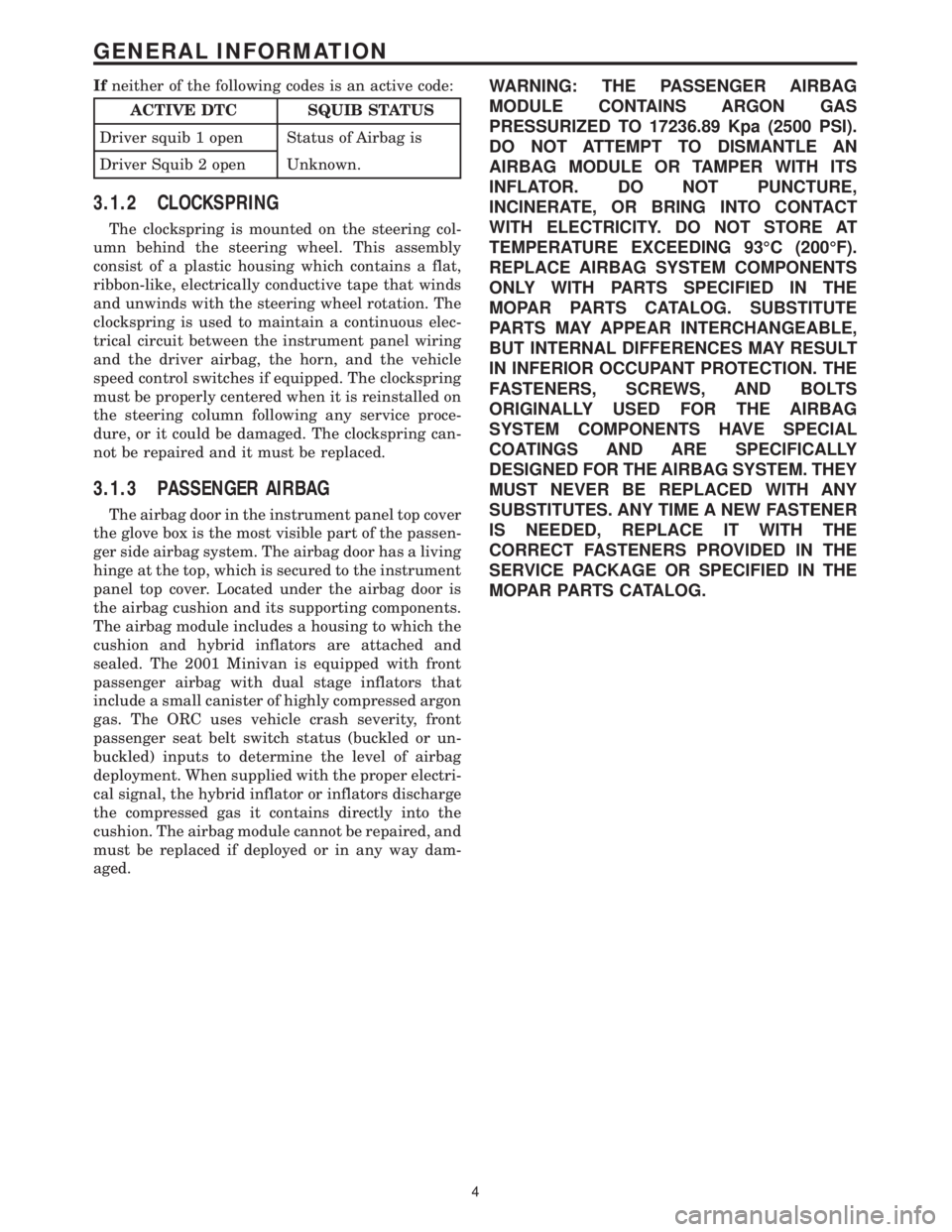
Ifneither of the following codes is an active code:
ACTIVE DTC SQUIB STATUS
Driver squib 1 open Status of Airbag is
Driver Squib 2 open Unknown.
3.1.2 CLOCKSPRING
The clockspring is mounted on the steering col-
umn behind the steering wheel. This assembly
consist of a plastic housing which contains a flat,
ribbon-like, electrically conductive tape that winds
and unwinds with the steering wheel rotation. The
clockspring is used to maintain a continuous elec-
trical circuit between the instrument panel wiring
and the driver airbag, the horn, and the vehicle
speed control switches if equipped. The clockspring
must be properly centered when it is reinstalled on
the steering column following any service proce-
dure, or it could be damaged. The clockspring can-
not be repaired and it must be replaced.
3.1.3 PASSENGER AIRBAG
The airbag door in the instrument panel top cover
the glove box is the most visible part of the passen-
ger side airbag system. The airbag door has a living
hinge at the top, which is secured to the instrument
panel top cover. Located under the airbag door is
the airbag cushion and its supporting components.
The airbag module includes a housing to which the
cushion and hybrid inflators are attached and
sealed. The 2001 Minivan is equipped with front
passenger airbag with dual stage inflators that
include a small canister of highly compressed argon
gas. The ORC uses vehicle crash severity, front
passenger seat belt switch status (buckled or un-
buckled) inputs to determine the level of airbag
deployment. When supplied with the proper electri-
cal signal, the hybrid inflator or inflators discharge
the compressed gas it contains directly into the
cushion. The airbag module cannot be repaired, and
must be replaced if deployed or in any way dam-
aged.
WARNING: THE PASSENGER AIRBAG
MODULE CONTAINS ARGON GAS
PRESSURIZED TO 17236.89 Kpa (2500 PSI).
DO NOT ATTEMPT TO DISMANTLE AN
AIRBAG MODULE OR TAMPER WITH ITS
INFLATOR. DO NOT PUNCTURE,
INCINERATE, OR BRING INTO CONTACT
WITH ELECTRICITY. DO NOT STORE AT
TEMPERATURE EXCEEDING 93ÉC (200ÉF).
REPLACE AIRBAG SYSTEM COMPONENTS
ONLY WITH PARTS SPECIFIED IN THE
MOPAR PARTS CATALOG. SUBSTITUTE
PARTS MAY APPEAR INTERCHANGEABLE,
BUT INTERNAL DIFFERENCES MAY RESULT
IN INFERIOR OCCUPANT PROTECTION. THE
FASTENERS, SCREWS, AND BOLTS
ORIGINALLY USED FOR THE AIRBAG
SYSTEM COMPONENTS HAVE SPECIAL
COATINGS AND ARE SPECIFICALLY
DESIGNED FOR THE AIRBAG SYSTEM. THEY
MUST NEVER BE REPLACED WITH ANY
SUBSTITUTES. ANY TIME A NEW FASTENER
IS NEEDED, REPLACE IT WITH THE
CORRECT FASTENERS PROVIDED IN THE
SERVICE PACKAGE OR SPECIFIED IN THE
MOPAR PARTS CATALOG.
4
GENERAL INFORMATION
Page 38 of 4284
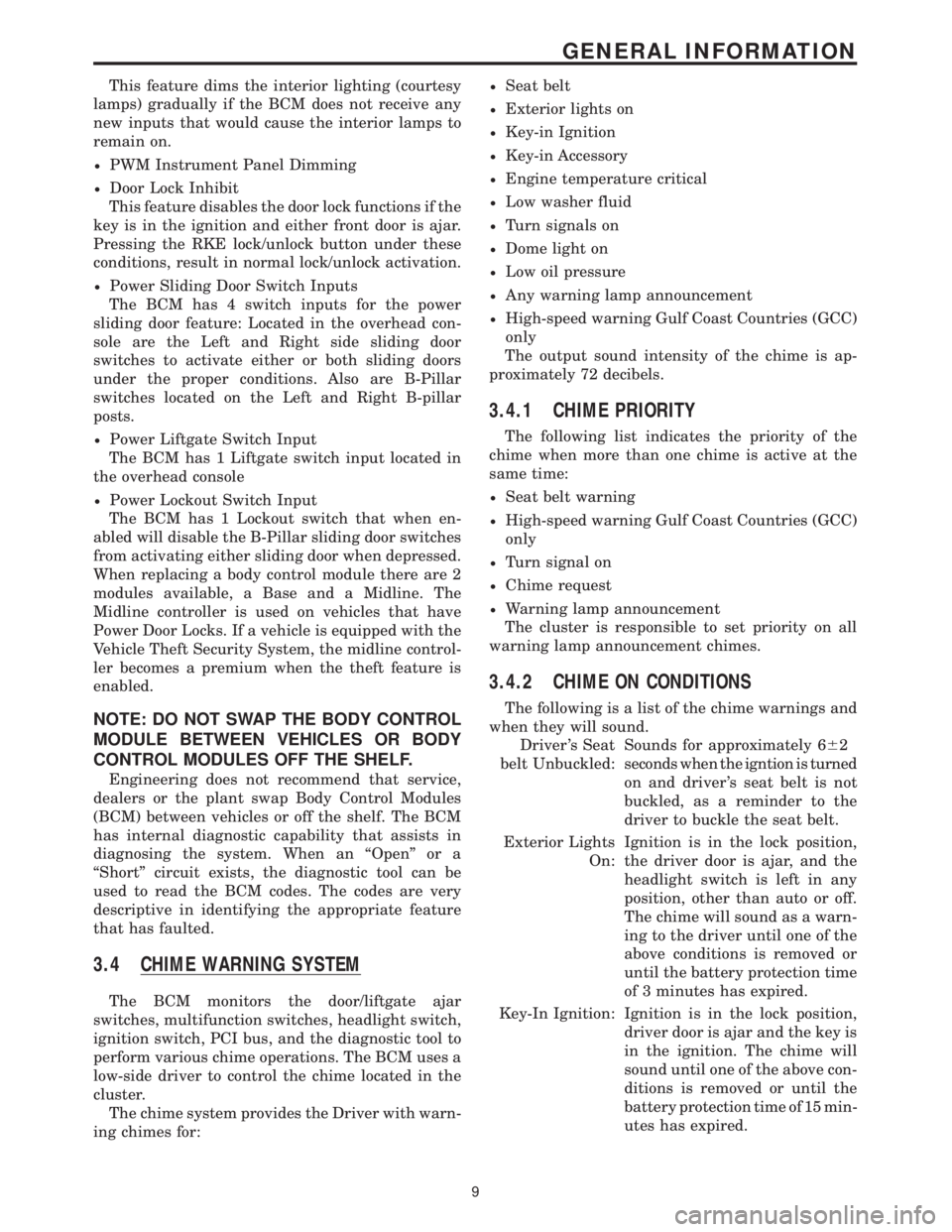
This feature dims the interior lighting (courtesy
lamps) gradually if the BCM does not receive any
new inputs that would cause the interior lamps to
remain on.
²PWM Instrument Panel Dimming
²Door Lock Inhibit
This feature disables the door lock functions if the
key is in the ignition and either front door is ajar.
Pressing the RKE lock/unlock button under these
conditions, result in normal lock/unlock activation.
²Power Sliding Door Switch Inputs
The BCM has 4 switch inputs for the power
sliding door feature: Located in the overhead con-
sole are the Left and Right side sliding door
switches to activate either or both sliding doors
under the proper conditions. Also are B-Pillar
switches located on the Left and Right B-pillar
posts.
²Power Liftgate Switch Input
The BCM has 1 Liftgate switch input located in
the overhead console
²Power Lockout Switch Input
The BCM has 1 Lockout switch that when en-
abled will disable the B-Pillar sliding door switches
from activating either sliding door when depressed.
When replacing a body control module there are 2
modules available, a Base and a Midline. The
Midline controller is used on vehicles that have
Power Door Locks. If a vehicle is equipped with the
Vehicle Theft Security System, the midline control-
ler becomes a premium when the theft feature is
enabled.
NOTE: DO NOT SWAP THE BODY CONTROL
MODULE BETWEEN VEHICLES OR BODY
CONTROL MODULES OFF THE SHELF.
Engineering does not recommend that service,
dealers or the plant swap Body Control Modules
(BCM) between vehicles or off the shelf. The BCM
has internal diagnostic capability that assists in
diagnosing the system. When an ªOpenº or a
ªShortº circuit exists, the diagnostic tool can be
used to read the BCM codes. The codes are very
descriptive in identifying the appropriate feature
that has faulted.
3.4 CHIME WARNING SYSTEM
The BCM monitors the door/liftgate ajar
switches, multifunction switches, headlight switch,
ignition switch, PCI bus, and the diagnostic tool to
perform various chime operations. The BCM uses a
low-side driver to control the chime located in the
cluster.
The chime system provides the Driver with warn-
ing chimes for:
²Seat belt
²Exterior lights on
²Key-in Ignition
²Key-in Accessory
²Engine temperature critical
²Low washer fluid
²Turn signals on
²Dome light on
²Low oil pressure
²Any warning lamp announcement
²High-speed warning Gulf Coast Countries (GCC)
only
The output sound intensity of the chime is ap-
proximately 72 decibels.
3.4.1 CHIME PRIORITY
The following list indicates the priority of the
chime when more than one chime is active at the
same time:
²Seat belt warning
²High-speed warning Gulf Coast Countries (GCC)
only
²Turn signal on
²Chime request
²Warning lamp announcement
The cluster is responsible to set priority on all
warning lamp announcement chimes.
3.4.2 CHIME ON CONDITIONS
The following is a list of the chime warnings and
when they will sound.
Driver 's Seat
belt Unbuckled:Sounds for approximately 662
seconds when the igntion is turned
on and driver 's seat belt is not
buckled, as a reminder to the
driver to buckle the seat belt.
Exterior Lights
On:Ignition is in the lock position,
the driver door is ajar, and the
headlight switch is left in any
position, other than auto or off.
The chime will sound as a warn-
ing to the driver until one of the
above conditions is removed or
until the battery protection time
of 3 minutes has expired.
Key-In Ignition: Ignition is in the lock position,
driver door is ajar and the key is
in the ignition. The chime will
sound until one of the above con-
ditions is removed or until the
battery protection time of 15 min-
utes has expired.
9
GENERAL INFORMATION